
There are ten schools of automotive mechanics in South Carolina. They also have many locations. It's easy to find one near you. Many schools offer multiple certificates and degrees. There are scholarships and grants available to help with the costs of school. A study permit you to also get a well-paying job. These are the top tips for anyone thinking about attending an auto mechanic school. Below are a few options.
Wake Tech
Raleigh, North Carolina recently opened an automotive facility. The school also added a collision repair degree program to its automotive technology program. Responding to a growing need for skilled collision repair technicians, the college offers diplomas and certificates in a variety of areas. The school currently has only 10 students in its collision repair program, but it plans to increase that number by 16 by June. This expansion will allow the school to reach its full enrollment goal which is 80 students.

To start the application process, complete an online form and attach your high school transcripts and college transcripts. Be sure to include the major code, as well as your placement test and advisor's name. After you submit the application, the DMV must be paid in cash or by post. The DMV offers many options when applying online and has a payment schedule to fit your schedule. You can also pay online to save time, money, and effort.
Wake Tech's auto mechanic school in South Carolina places students in an excellent position to pursue a career as an automotive technician. The school is situated on the way to employment. The school recently opened the Hendrick Center for Automotive Excellence. It will triple student enrollment in its collision repair program and automotive systems technology program. The new facility includes a laboratory of 7,000 feet that students can use to study collision repair or body shop operations.
Midlands Technical College
Midlands Technical College in South Carolina is an excellent choice for anyone looking for a school of auto mechanics. The college is located in several locations across South Carolina. It has approximately 16,000 students and is the largest two-year college in the state. The courses are designed to be completed in three years. However, there are no graduation requirements. Midlands offers many automotive programs. However, they also have an online learning system that allows students online to earn their certificates or diplomas.
Midlands Technical College's AutoMechanics program prepares students to work in many different settings, such as special shop technicians, department-store service mechanics, and emissions inspectors. They are also qualified to become certified in the repairs of cars, trucks, motorcycles and other vehicles. They can also find jobs in dealerships and specialty shops as well as emissions inspection stations after completing their program. Students are taught how to apply technical expertise to a wide range of automotive systems. This includes engine repair and suspension, steering, heating, and air conditioning.

Although you don't require a license to become an auto mechanic in South Carolina it will help increase your career prospects and improve your earning potential. South Carolina has many auto mechanic schools that offer various levels of training. These range from certificate programs to associate degrees. For example, Central Carolina offers a certificate in automotive technology, while Midlands provides an Associate Degree in automotive technology that requires 84 credit hours. The program is accredited by the NATEF, which ensures quality education and a competitive salary.
FAQ
Does it matter what college I go to?
No, not really. There's no difference between colleges regarding getting into the automotive industry. However, some schools offer better programs than others so if you're looking for something more specialized, look elsewhere.
Is it difficult to find a job as a mechanic in the automotive industry?
Yes, it is possible. Many garages advertise their vacancies online, and many people apply just because they think it might be fun. If you want to get your foot in the door, you should try applying for a few places and see if they accept student applications. If you don't know anyone working in the industry, ask your friends and relatives. They may be happy and willing to recommend someone.
To be a car mechanic, do you need a degree? Can I study part-time?
A degree isn't necessary, but it certainly helps. Employers are more likely to hire candidates who have completed a complete degree. It shows you are dedicated and have worked hard to achieve your goals.
You can still study while working, however. Some universities let students complete their coursework in the summer and then continue their studies during the school year. Others let students take classes part-time throughout the year.
Statistics
- The U.S. Bureau of Labor Statistics (BLS) reports that the job outlook for automotive service technicians and mechanics is expected to decline by 4% from 2019 to 2029. (indeed.com)
- 52% of Mechanics in the United States think their salaries are enough for the cost of living in their area. (indeed.com)
- Apprentice mechanics earn significantly less hourly than mechanics who have completed training, with a median wage of approximately $14.50 an hour, according to PayScale. (jobhero.com)
External Links
How To
How to correctly diagnose your vehicle for repairs
The symptoms of your vehicle are the first thing you need to look at in order to determine whether it is in dire need of repairs. These steps will help you diagnose your car properly.
-
Check engine lights. Make sure to check all dashboard indicators like the engine light indicator (oil pressure gauge), the battery indicator (battery light indicator), and the RPM indicator (rpm gauge). You may have a problem with your vehicle if any of the indicators are flashing for more than a few days.
-
Examine the treads of the tires. If the tires are worn out, they could cause problems with handling and braking. You should inspect the treads on your wheel. They should be clean, and they should be smooth. It is best to take off the wheels and remove them. Use a flashlight to see how well the treads are worn.
-
Monitor the level and consistency of your brake fluid. It is important to keep track of how much brake fluid you have in your car. This ensures that your brakes work properly. Your brakes may fail if the brake fluid level drops.
-
You should test the suspension system. Vehicles usually have a suspension system that helps absorb shocks and vibrations while driving. It gives you better control and allows for smoother accelerations and decelerations. Your vehicle might feel wobbly, or shake uncontrollably if it has a bad suspension. You can test if your vehicle has a suspension problem by putting weight on either the front or back axle to see how it moves.
-
Examine the steering column. The steering column is used to link the steering wheel with the rest of vehicle's components. Many accidents can cause damage to steering columns. If yours feels loose or shaky, you should replace it.
-
Observe the exhaust pipes. Exhaust pipes help move gases from the combustion chamber to the atmosphere. If the exhaust pipe is damaged or leaks, harmful fumes can enter your cabin. If your tailpipe bends, it is important to fix it immediately.
-
Take a look under your hood. Look underneath your hood to see if anything looks strange. You could have fluids leaking from the engine. In addition, if you notice an unusual smell coming from your engine compartment, you should contact a professional technician.
-
It is important to inspect the air filter. The outside environment can collect dust and other debris in your vehicle's air filters. A dirty filter can lead to a poor vehicle's performance. Replace your air filter regularly.
-
The fan belt should be checked. The fan belt is the link between the engine and the transmission. If the fanbel breaks, your engine won't turn. It's easy to replace the belt. You will need a screwdriver, pliers and a pair of pliers.
-
Verify the radiator hoses. The radiator hose is used to carry water from the radiator to your engine. If it becomes cracked or damaged, it can leak hot liquid onto the engine. Repairing the hose is easy with a pair of needlenose pliers or a small wire brush.
-
Check the windshield wipers. Windshield wipers use electricity to wipe away rain and snow. They can leave streaks on your windows glass if they stop working. Simply change the washer oil to fix the problem.
-
Check the battery cables. The batteries provide power to the electrical systems within your car. If you are replacing batteries, disconnect the negative cord first. Failure to do so can damage your alternator.
-
Pay attention to your headlights. Headlights help you see the road ahead. If they don't work properly, it can cause poor visibility. Check the bulbs to see if they've burned out.
-
Always check your lights. If you approach other drivers at night, lights will warn them. You could be distracted and cause an accident if one does not work.
-
Check your brakes. Before you collide with another vehicle, brakes will slow down the car. If the brakes fail to work correctly, your car could lose control and collide with another vehicle.
-
Make sure to change the oil. Keep your engine lubricated with oil. This oil helps to prevent metal parts becoming too worn out. It is recommended that the oil be changed every other month.